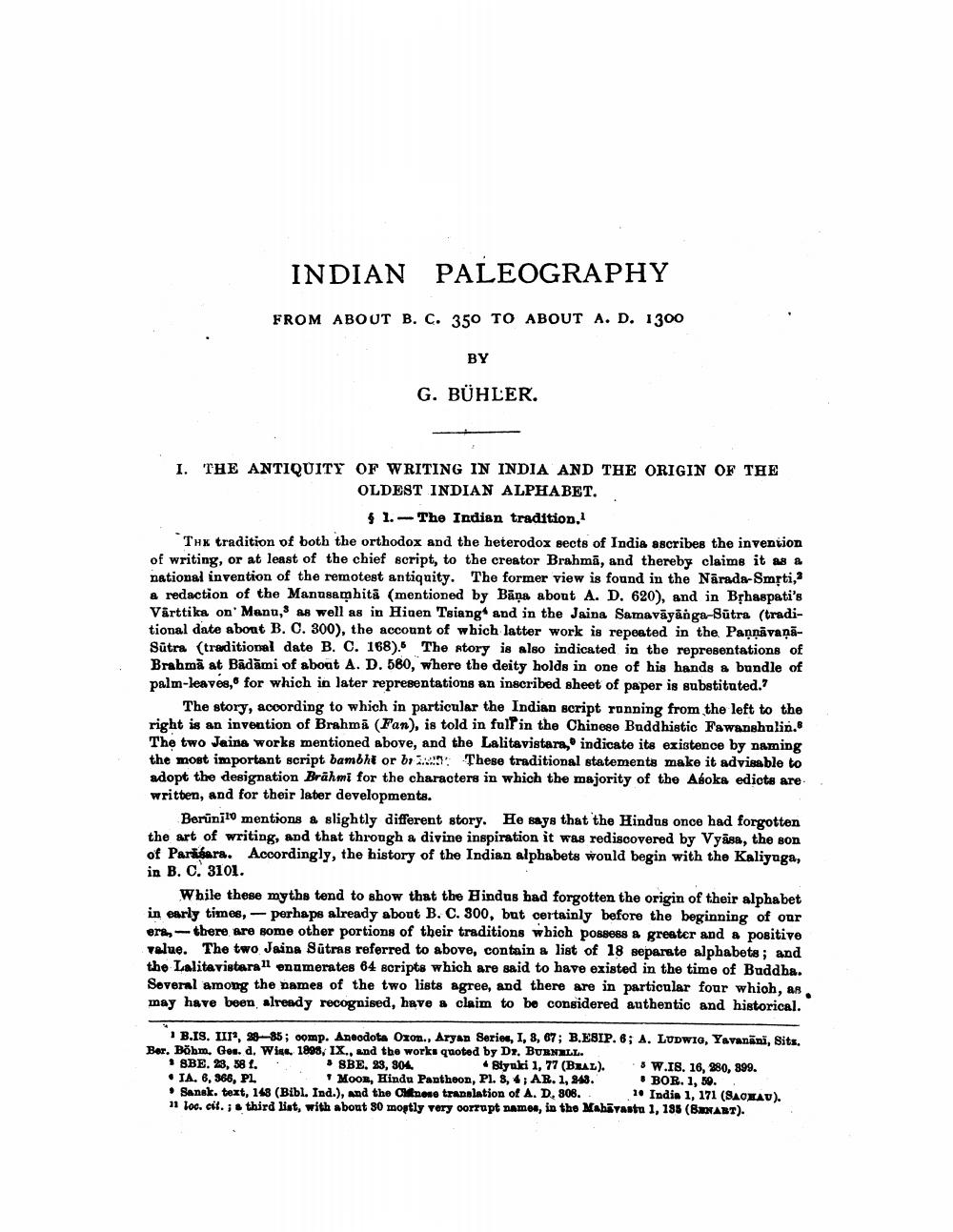________________
INDIAN PALEOGRAPHY
FROM ABOUT B. C. 350 TO ABOUT A. D. 1300
BY
G. BÜHLER.
1. THE ANTIQUITY OF WRITING IN INDIA AND THE ORIGIN OF THE
OLDEST INDIAN ALPHABET.
$1. -The Indian tradition. Thx tradition of both the orthodox and the heterodox sects of India ascribes the invention of writing, or at least of the chief script, to the creator Brahmā, and thereby claims it as & national invention of the remotest antiquity. The former view is found in the Nārada-Smrti, a redaction of the Mannsamhita (mentioned by Bāņa about A. D. 620), and in Bphaspati's Värttika on Mant, as well as in Hinen Tsiang and in the Jaina Samavāyanga-Sūtra (traditional date about B. C. 300), the account of which latter work is repeated in the PannāvaņāSūtra (traditional date B. C. 168). The story is also indicated in the representations of Brahmä at Badāmi of about A. D. 580, where the deity holds in one of his hands a bundle of palm-leaves, for which in later representations an inscribed sheet of paper is substituted.?
The story, according to which in particular the Indian script running from the left to the right is an invention of Brahma (Fan), is told in full in the Chinese Buddhistic Fawanghulin. The two Jaina works mentioned above, and the Lalitavistara, indicate its existence by naming the most important script bambht or bry. These traditional statements make it advisable to adopt the designation Brāhmi for the characters in which the majority of the Aboka edicts are written, and for their later developments.
Berünito mentions a slightly different story. He says that the Hindus once had forgotten the art of writing, and that through a divine inspiration it was rediscovered by Vyāsa, the son of Paribara. Accordingly, the history of the Indian alphabets would begin with the Kaliyuga, in B. C. 3101.
While these myths tend to show that the Hindus bad forgotten the origin of their alphabet in early times, - perhaps already about B. C. 300, but certainly before the beginning of our ers, there are some other portions of their traditions which possess a greater and a positive value. The two Jaina Sūtras referred to above, contain a list of 18 separate alphabets; and the Lalitavistara 11 onamerates 64 scripts which are said to have existed in the time of Buddha. Soveral among the names of the two lists agree, and there are in particular four which, An. may have been already recognised, have a claim to be considered authentic and historical.
1 B.IS. III, 28-85; comp. Anecdota Oxon., Aryan Series, I, 8, 67; B.EBIP. 6; A. LUDWIG, Yavanāni, Sits.
. Gord, Wise, 1898, IX., and the works quoted by Dr. BURNILL. • SBE. 23, 58 . .
SBE, 83, 804.
.Biyuki 1, 77 (BEAL). SW.18. 16, 380, 899. •JA. 6, 368, PL . Moon, Hindu Pantheon, Pl. 3, 4; AR. 1, 948.
BOB. 1, 59. • Sansk. text, 148 (Bibl. Ind.), and the Oltrone translation of A. D, 908. 10 India 1, 171 (SACKAU). 11 loc. cit.; third list, with about 80 moptly very corrupt namor, in the Maharastu 1, 195 (BHXABT).




